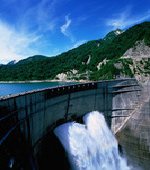 Direct Potable Reuse: The Future
Direct Potable Reuse: The Future
Factors such as population growth and climate change mean that existing water supplies must go further in the future; one way to achieve this is to implement direct potable reuse (DPR) of purified water within current water distribution systems. University of California researchers have published an article in the recently launched Journal of Water Reuse and Desalination describing DPR and its future expectations.Direct potable reuse (DPR) refers to the introduction of purified water, derived from municipal wastewater after extensive treatment and monitoring, directly into a municipal water supply system. The obvious advantage of DPR is the opportunity to reduce the distance that purified water would need to be pumped, significantly reducing costs. DPR has the potential to allow for full reuse of available purified water in metropolitan areas, using the existing water distribution infrastructure.
Harold Leverenz and co-authors point out that the biggest problem with DPR is community acceptance. However, the distinction that natural water is pure and better is no longer valid in many areas, mostly due to discharges of wastewaterand agricultural and urban runoff. The authors quote Dr Lucas van Vuuren who said 40 years ago: "Water should not be judged by its history, but by its quality".
A preference for indirect potable reuse (IPR) has been evident in the past, since a reliable source of water of a particular quality is required. IPS systems make use of an engineered storage buffer (EBS), which provides a safety net in that the need for any further treatment can be detected before distribution. However, EBS systems have their own problems in that any purified water may be exposed to environmental contaminants.
Leverenz and co-authors list the factors favouring DPR: (1) advances in watertreatment technology have made large-scale water purification the most sustainable water supply option in some areas; (2) water supply can remain local and can be recycled securely and indefinitely; (3) water of the highest quality can be provided for human consumption; (4) water quality can be verified using ESBs; (5) liability associated with environmental discharges are avoided, and (6) existing source waters can be diverted to agricultural and environmental uses.
Through flow diagrams describing wastewater treatment processes at a number of locations (e.g. Namibia, Texas, California and New Mexico), the authors highlight the "incrementalist" nature of many WWTPs; the production of water for DPR was basically an afterthought with additional unit processes simply tacked on to the end of existing secondary treatment processes. The authors argue that, at some point in the near future, integrated water management systems must be developed in which new wastewater treatment plants are planned and designed to optimisetreatment performance with respect to the production of purified water, along with the recovery of energy and resources.
Leverenz and co-authors conclude: "For a variety of environmental, demographic and climatological factors, it is imperative that communities large and small begin to develop plans for improving their water portfolios to meet future needs. Effective planning for DPR will be important in achieving water security without major dislocations."
Interested readers should also refer to the report Direct Potable Reuse: A Path Forward, prepared for the WateReuse Research Foundation and WateReuse California.
The recently launched Journal of Water Reuse and Desalination (IWA Publishing) publishes refereed review articles, theoretical and experimental research papers, new findings and issues of unplanned and planned reuse. It addresses one of the major challenges of the 21st century: the provision of additional sources of safe water to address increasing demand originating from population growth, economic improvements and the impacts of climate change. The first issue is available free of charge online at: http://www.iwaponline.com/jwrd/ .
Source: Harold L. Leverenz, George Tchobanoglous and Takashi Asano. 2011. Direct potable reuse: a future imperative. Journal of Water Reuse and Desalination, IWA Publishing, 1(1), 2-10.
| Contact information | n/a |
|---|---|
| News type | Inbrief |
| File link |
http://www.waterlink-international.com/news/id2004-Direct_Potable_Reuse_The_Future.html |
| Source of information | http://www.waterlink-international.com |
| Keyword(s) | water supply management, water supply and demand, water scarcity, water resource, water economy, water distribution area, water demand management, renewable water resource, environmental policy, environmental protection, geopolitics, international organization, sustainable development, sustainable development strategy, water actor, water management |
| Subject(s) | DRINKING WATER , DRINKING WATER AND SANITATION : COMMON PROCESSES OF PURIFICATION AND TREATMENT , HEALTH - HYGIENE - PATHOGENIC MICROORGANISM , INFORMATION - COMPUTER SCIENCES , SANITATION -STRICT PURIFICATION PROCESSES , WATER DEMAND , WATER QUALITY |
| Geographical coverage | n/a |
| News date | 20/07/2011 |
| Working language(s) | ENGLISH |
 you are not logged in
you are not logged in





